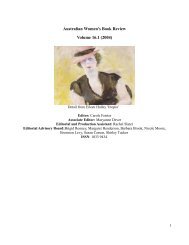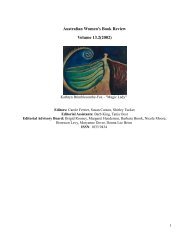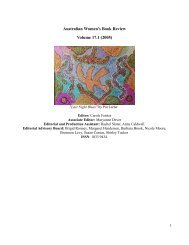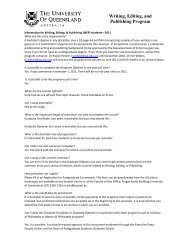Australian Women's Book Review Volume 14.1 - School of English ...
Australian Women's Book Review Volume 14.1 - School of English ...
Australian Women's Book Review Volume 14.1 - School of English ...
You also want an ePaper? Increase the reach of your titles
YUMPU automatically turns print PDFs into web optimized ePapers that Google loves.
simultaneous affirmation and deconstruction <strong>of</strong> identity (politics) in the poetry/theory <strong>of</strong> working class<br />
lesbians and lesbians <strong>of</strong> colour. Thus, much <strong>of</strong> her textual analysis focuses on issues <strong>of</strong> identity. This is<br />
partly in response to the familiar (and, as Moira Gatens puts it, tired and tiring) charge <strong>of</strong> essentialism<br />
that is <strong>of</strong>ten directed towards lesbian feminism. The insistence on identity may also be read as<br />
symptomatically reflecting the poststructuralist impact upon theorisations <strong>of</strong> identity more generally.<br />
Thus in the chapter on white American poet Judy Grahn, Garber points to Grahn's reclamation <strong>of</strong> words<br />
such as 'queer' and 'dyke' in her poetry about working-class women, the emphasis on the free play <strong>of</strong><br />
language, and a nascent critique <strong>of</strong> what queer theory knows as 'heteronormativity.' Similarly, Garber<br />
reads Black American poet and activist Pat Parker's poetry as pre-empting postmodern or queer notions<br />
<strong>of</strong> identity by refusing a singular and unified subjectivity - reflecting on the differences within. For<br />
Garber, Parker's work also begins to articulate a critique <strong>of</strong> the nature <strong>of</strong> differences between women,<br />
analysing the silences and exclusions around class and race within the women's movement and lesbian<br />
feminism. A similar critique <strong>of</strong> identity is also located in the work <strong>of</strong> Audre Lorde, the Black American<br />
writer, activist and lesbian feminist, who Garber reads as drawing on various myths, histories and<br />
identities in order to articulate not an essential or archetypal identity, but a 'postmodern lesbian-feminist<br />
identity poetics' (112). Other elements <strong>of</strong> Lorde's work that Garber reads as 'queering' stereotypes <strong>of</strong><br />
lesbian feminism are an emphasis on sexuality (instead <strong>of</strong> the prudish and humourless caricature <strong>of</strong><br />
lesbian feminism), and a deployment <strong>of</strong> a 'strategic essentialism' that has more recently been associated<br />
with theorists such as Gayatri Spivak, Diana Fuss and Elizabeth Grosz.<br />
Placing Adrienne Rich next to Lorde as one <strong>of</strong> the most prominent voices <strong>of</strong> lesbian feminism, Garber<br />
discusses the way in which these authors have frequently been read out <strong>of</strong> context, understanding this<br />
as part <strong>of</strong> the reason why elements <strong>of</strong> Rich's work have been repeatedly invoked as representative <strong>of</strong><br />
the sins <strong>of</strong> lesbian feminism. Promoting a more detailed re-reading <strong>of</strong> Rich, Garber draws out links<br />
between Rich's well known concept <strong>of</strong> compulsory heterosexuality and queer theory's (and in<br />
particular, Judith Butler's) critique <strong>of</strong> the heterosexual matrix. Similarly, Rich's formulation <strong>of</strong> the<br />
lesbian continuum (reading a range <strong>of</strong> relationships between women as 'lesbian') is not represented in<br />
terms <strong>of</strong> a gender/sexuality (or a queer versus lesbian feminism) oppositionality. Instead, Garber<br />
analyses the motivations underlying the lesbian continuum and queer as similar; both 'draw attention to<br />
sexual identities that are suppressed by heterosexism, and . . . construct disruptive, insurgent categories<br />
<strong>of</strong> identity that fly in the face <strong>of</strong> the terms' typical usages' (137).<br />
Finally, Garber reads the work <strong>of</strong> Chicana cultural theorist and poet Gloria Anzaldúa as a bridge<br />
between the poetry <strong>of</strong> Grahn, Parker, Lorde, and Rich, and the emergence <strong>of</strong> queer in the early 1990s.<br />
As with these writers, Anzaldúa's work is understood to be decidedly queer in terms <strong>of</strong> the<br />
problematising <strong>of</strong> identity, and <strong>of</strong> the categories theory/poetry. Although Anzaldúa consciously invokes<br />
the term queer, as well as an identity, or identities, that are self-consciously liminal and borderline (see<br />
Anzaldúa's <strong>of</strong>t-cited Borderlands/La Frontera), Garber is careful to link her work with that <strong>of</strong> the<br />
emergence <strong>of</strong> a specific Chicana feminism in the 1980s and the deployment <strong>of</strong> a strategic essentialism,<br />
rather than appropriating her work to a completely queer or postmodern deconstruction <strong>of</strong> identity.<br />
There are two potential risks in Garber's project - either too thorough appropriation <strong>of</strong> lesbian feminism<br />
by queer theory, or an uncritical celebration <strong>of</strong> lesbian feminism. Garber is on the whole careful not to<br />
realign the work <strong>of</strong> Grahn, Parker, Lorde, Rich, and Anzaldúa with a queer agenda, for to do would<br />
misrepresent these women and their work, as well as the social and historical importance <strong>of</strong> the<br />
expression and theorisation <strong>of</strong> a specifically lesbian feminist identity and politics: 'Although I argue<br />
that lesbian feminism is neither as white, middle class, nor antiqueer as it has been portrayed, neither<br />
61








